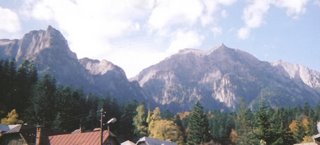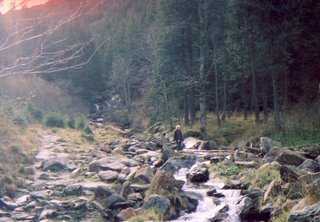Transfagarasan Pass
Carpathian Mountains
 Carpathian Mountains, Transfagarasan Pass, Romania
Carpathian Mountains, Transfagarasan Pass, Romania
1. Blasting open the Pass
The Fagaras Mountains, are part of the Carpathian Range. Wallachia is on one side. Vlad III Tepes was Wallachian. Transylvania is on the other.
At the northern end of the pass are the cities of Sighisoara, the
birthplace of Vlad III Tepes, and Sibiu; entry to the painted monastery
areas, and much more.
There is a history of hardship and labor deaths here, from blasting a way across and through a tunnel, for vehicles. See
http://www.expeditionplus.com/2006/07/the_fagaras_mountains_and_the_1.
The Pass was built as a way to move troops and ammunition to defend against a feared Soviet invasion in 1968. The Transfagarasan Pass, through and over the Transfagarasan Mountains, is more easily remembered by the name of the town at the north side, Fagaras. See
http://www.transylvania-discovery-tours.ro/en/top/daily-tours-in-transylvania/land-of-fagaras-day-tour/
2. Accessibility
The Pass in these mountains is open as weather and season permit. This was the end of October - lovely for leaves, views, but beginning risky for weather. With snow the tunnels and high switchbacks are closed. Check at Curtea de Arges before launching out in this direction. There will be a sign, not big, affirming whether the pass is open. On maps, the road will look as though it stops. Instead, that open bracket symbol means tunnels.
Cabanas is the magic word. There are hotel-type places for sleeping, called Cabanas. Are they government-run? Not sure. Just don't let it get dark on you. Stop in time. For an overview of the mountains in Romania, see "Romania's Road to Heaven," at
http://www.escapeartist.com/efam/68/Living_In_Romania.
On the way, we knew there would be "cabanas" or small hotels, but did not expect the distances between. Don't wait too long in the day to stop. You need all the visibility you can get - not all vehicles have good headlights, and animals may wander in the road. We were just about to turn back, when one appeared. Do not expect signs to tell you when the next will emerge.
3. Stop the car, park and trust, and hike.
 Transfagarasan Pass, midday hike, Romania
Transfagarasan Pass, midday hike, Romania
Stop along the way and take a hike. If you are a worrier about leaving the car, you will miss out. We never had a problem. Look closely: There is half of the Car-Dan Tour Company, snapped by the other half, as we crossed a boulder-strewn creek bed with no particular destination in mind.
The car was indeed there when we returned.
Other attractions: See
http://www.expeditionplus.com/2006/07/the_fagaras_mountains_and_the_1.
 Rasnov area, Romania. Cows of the household
Rasnov area, Romania. Cows of the household Sinaia, Peles Castle, Romania
Sinaia, Peles Castle, Romania Curtea de Arges, Monastery, Romania
Curtea de Arges, Monastery, Romania Dan Widing at Poinari Citadel, Vlad Dracula's castle ruin, Transfagarasan Pass, Carpathian Alps, Romania
Dan Widing at Poinari Citadel, Vlad Dracula's castle ruin, Transfagarasan Pass, Carpathian Alps, Romania Poinari Castle, Poinari Citadel, peak, at left, Transylvania, Romania
Poinari Castle, Poinari Citadel, peak, at left, Transylvania, Romania  Dan Widing climbs path to Poenari Citadel, Castle, Vlad Tepes, Romania
Dan Widing climbs path to Poenari Citadel, Castle, Vlad Tepes, Romania View from Poenari Citadel, Castle ruin, Vlad Tepes, Romania
View from Poenari Citadel, Castle ruin, Vlad Tepes, Romania Dan Widing with guide at Poienari Citadel, Vlad Fortress, Romania
Dan Widing with guide at Poienari Citadel, Vlad Fortress, Romania Dracula Rooming House, a Pensione, Arefu, Romania
Dracula Rooming House, a Pensione, Arefu, Romania Carpathian Mountains, Transfagarasan Pass, Romania
Carpathian Mountains, Transfagarasan Pass, Romania Transfagarasan Pass, midday hike, Romania
Transfagarasan Pass, midday hike, Romania